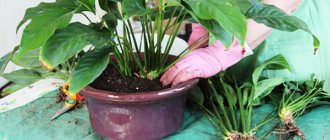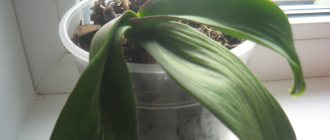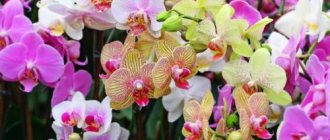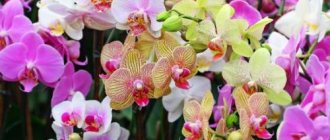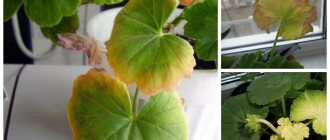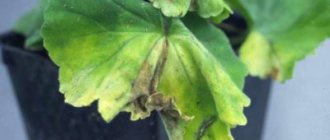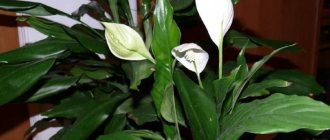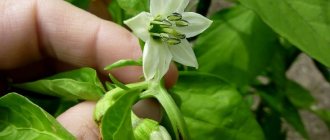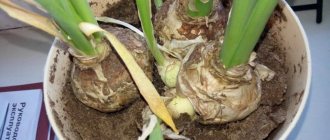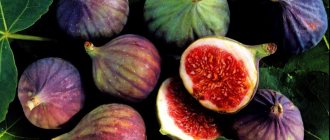Description with photo
The peduncle of this orchid has a sharp tip and a shape resembling a closed beak. It grows from a neck in the center of the leaf and only stretches upward. Next in the photo you can see what the flower stalk of the plant looks like.
Your orchid has released a flower stalk - how to care for it?
There is no doubt that the orchid is one of the most wonderful and beautiful creations of nature during the flowering period.
The color range, variety of shapes and sizes, long-lasting flowering amaze the imagination of the gardener who decides to grow a tropical beauty at home.
To achieve such beauty, you have to devote a lot of time to an exotic beauty , cherish and groom her. And how much delight there was when the labors were not in vain and the orchid released a flower-bearing arrow - a sign of imminent flowering.
In order for the peduncle to fully develop, gain the required number of buds and fully bloom, you need to know some rules and features of caring for it. It is the flowering that is its decorative value.
How to distinguish from the root or other parts of the orchid?
When the phalaenopsis just begins to develop a peduncle, it can be mistaken for the root or even the baby of the plant, so you need to know how they differ from each other. It can be distinguished from the root by the following characteristics:
- it is necessary to carefully examine the place where the new growth appeared and determine its location relative to the growth point - if it grows from the stem and is located on the root collar between the leaves - this is not a peduncle, but an aerial root;
- the arrow always grows upward, while the roots are slightly inclined downward;
- the color of the roots is greenish-gray and bright green at the tips, while the arrow is monochromatic along the entire length;
- the root is smooth, and the peduncle is divided by small scales;
- the peduncles have a sharp tip, and at the roots it is rounded and blunt.
Differences between the peduncle and the basal child:
- after the baby grows a little, its tip will begin to resemble a boat shape;
- The peduncle grows only from the base of the central vein of the leaf, and the baby, as a rule, grows just above the place of the previous flowering.
We invite you to watch a video on how to distinguish a peduncle from a root in phalaenopsis:
Living conditions in the apartment
Orchids are plants of tropical climates , where monsoon rains are followed by relatively dry periods. In an apartment, the dry period occurs in the winter; at this time, the flower enters a dormant period, when it is necessary to reduce the amount of watering and fertilizing, and lower the temperature.
The factors determining the development of the peduncle include:
Orchids can only bloom in optimal conditions.
The plant is sensitive to indoor drafts, which can negatively affect the formation of the peduncle. If you have an orchid without a peduncle, what should you do first? First, find out about the necessary flowering conditions.
Features of care during the growth period
The period of peduncle growth is a very important moment in the life of an orchid, when it is especially important to provide it with good care.
- It is necessary to provide the plant with good lighting. Daylight hours for a phalaenopsis that has released a shoot should be at least 12 hours. In autumn and winter, you need to place a pot with an orchid on the window sill on the south side of the room, and if this is not possible, you should use a phytolamp for additional lighting.
- Humidity needs to be maintained at an optimal level; for this you can use a humidifier or place a container of water next to the orchid. This is especially important in winter when the indoor air is too dry.
- It is imperative to feed the plant with fertilizers that contain a lot of phosphorus and potassium from the moment the peduncle has just begun to form until the flowers appear on it. After the flowers appear, fertilizing should be suspended, as this will not increase the splendor of flowering, but may provoke a drop of flowers.
- Watering is carried out as usual - as the soil dries out. The regularity is individual for each specific case, as it depends on the temperature and humidity of the air. Phalaenopsis with a regrown peduncle does not need direct spraying; it will most likely destroy the sprout. It is enough to place a flowerpot with an orchid between other plants while spraying them and it will have enough moisture.
Important! Under no circumstances should the soil in the flowerpot be allowed to become completely dry.
Video about caring for phalaenopsis during the period of peduncle growth:
The necessary conditions
During the formation of the peduncle, the brightest place is chosen. Since the awakening of meristems usually occurs in autumn, depending on the region of growth, attention should be paid to the power of sunlight.
In more northern regions, during this period the sun is not so scorching and it is possible to place orchids even on a southern window. If the sunlight is still powerful, then it is necessary to place the orhu so that it is diffused. But you should not place it on the north side.
Orchids need to be shaded from direct sunlight.
Before the bulk of the flowers appear, the location cannot be changed , otherwise the formation of buds will be delayed due to the resulting stress. The amount of daylight during this period should not be less than 12 hours. If there is a lack of light, you should use additional lighting using a phytolamp.
Watering
Watering should continue as usual - be moderate. Depending on the growing conditions, the regularity of watering is carried out differently. This could be once every one, two or even four weeks. The state of the substrate should serve as a guide . After watering, it should dry completely.
Fertilizers
Those fertilizers that were applied before the flowering arrow appeared continue to be applied in combination with watering. The supply of nutrition stops with the appearance of the first flower.
The fertilizers that were applied before and during the formation of the arrow determined the number of flowers on it. Excess can significantly shorten flowering time.
Therefore, adding additional nutrition is important before, and not during flowering .
Formation period
How quickly does it form?
Let's consider how long the peduncle of an indoor phalaenopsis orchid grows. The average time for its formation in a regular phalaenopsis is two months, in a hybrid one – three. This is exactly how much time must pass after the appearance of the stem before the peduncle is fully formed. If the plant is in comfortable temperature conditions and receives the required amount of light and moisture, then this time will decrease by 1.5-2 times.
The lateral peduncle develops faster - in about 1.5 months.
How many arrows does it fire?
The most common type is phalaenopsis, which has 2-3 peduncles, but there are also specimens with a large number of peduncles. At home, the number of arrows depends on the type of phalaenopsis, its health and the care provided.
The number of buds in an orchid increases under extreme conditions, for example due to temperature changes, drought or an unusually large amount of light.
How to ensure growth?
How to grow a flower stalk? In order to grow it, you first need to make sure that the new growth on the phalaenopsis is actually an arrow. If this is the case, then you need to wait until it reaches a length of 15-20 cm and fix it in a vertical position, tying it to a support in a flowerpot.
It is best to use a special clothespin for this, which can be purchased at any flower shop, but you can also use a regular hair elastic or a small hair clip. If you can’t tie the peduncle to the support, you just need to rotate the pot with the orchid relative to the light.
Peduncle from the growing point - will the orchid die?
No, it won’t die, but it won’t bring you new blooms anytime soon!
Under normal conditions, the peduncle of an orchid appears from the axil of the leaf. However, you can often buy an orchid on sale whose peduncle is located exactly at the growing point. These are the so-called instant-forcing or myriclonized orchids.
It is this rosette that will no longer grow after flowering, but it will begin to form children. Babies may appear from under the lower leaves or on the peduncle itself. All we have to do is wait for the children to grow up and bloom.
In rare cases, it happens that the plant forms a new growth point from the axils of the upper ones and begins to grow sideways.
The mother plant with a peduncle from the center of the rosette can produce repeated flowering, but in this case it will give birth to children later. Therefore, it is better to prune it before the end of the first flowering. Pruning is carried out above 2-3 buds, the cut is powdered with ground cinnamon, charcoal powder or treated with brilliant green. Reduce watering to once every 10-12 days.
Between waterings, it is necessary to fertilize the leaves with nitrogen-containing fertilizers.
For the first month, such feeding is alternated with spraying with water with the addition of Zircon or Ribav Extra.
It is also useful to sometimes give the orchid a shower with warm water (40-45 degrees) for 1-2 minutes.
With this care, babies appear in 3-5 months. They are not separated from the mother plant for quite a long time (up to several years) until they grow and become stronger.
If the baby appears on a peduncle, you need to wait until its leaves reach a length of 2-3 cm, then wrap the base of the baby with sphagnum and periodically moisten it with water. This way the baby forms roots faster. When the roots reach a length of about 5 cm, the baby can be separated.
myflo.ru
Step-by-step instructions: what to do in a certain situation?
Let's consider what to do if the peduncle that grows from the growth point breaks or other possible cases:
- Grows from a growing point. This happens if the phalaenopsis has already undergone many flowering cycles or has experienced severe stress. In this case, you don’t need to take any action, you just need to take care of the plant and, perhaps, buds or babies will appear on the arrow.
- Broken. In this case, you need to cut the peduncle to the bud located closest to the fracture site and treat the cut site with crushed activated carbon, wood ash or cinnamon powder.
Important! You should not try to glue or connect the fragments in any other way - this will only harm the flower. - Absent at all (you can find out why phalaenopsis does not bloom and how to correct the situation here). You can stimulate the flowering stalk by arranging a slight stressful situation for the plant. To do this, you can, for example, slightly limit the access of light to the flower or water it less often. Of course, it is impossible to bring things to a complete drought. If possible, you can lower the air temperature at night by 5-6 degrees.
- Stopped growing. To begin with, it is necessary to exclude disease or the presence of pests from the list of possible causes. After making sure that the flower is healthy, you should once again reconsider the care of the plant and make sure that it has enough nutrients and moisture, enough light, and that the temperature and humidity levels are comfortable. If the phalaenopsis is not sick and the conditions for keeping it are suitable, but the peduncle still does not grow, you can only wait - if the arrow has not dried out, the orchid can still bloom.
We tell you everything about phalaenopsis flower stalks: pruning, rooting and other issues
Phalaenopsis quickly gained popularity among indoor plant lovers thanks to its unusual flowers collected in an exquisite inflorescence. This type of orchid is quite easy to care for , and flowering can last from several weeks to several months.
The plant needs special attention during the formation of the peduncle and after the flowers have fallen off. If simple requirements are met, this flower will delight you with regular, lush blooms. This article contains everything about phalaenopsis flower stalks: pruning, rooting and other issues.
Peduncle of phalaenopsis
The peduncle of phalaenopsis is a fairly high arrow, at the top of which an inflorescence is formed - a raceme .
The peak formation of flowering arrows occurs in early autumn . At this time, night temperatures begin to differ significantly from daytime ones.
It usually appears from under the leaf in the form of a small greenish cone. During this period, the flower shoot is easily confused with the developing root, which has a more rounded shape.
Only when the length of the hatched bud is more than 1 cm can you say for sure what kind of shoot it will be - vegetative or flowering.
Care
During the formation of the flower-bearing arrow, phalaenopsis needs special attention:
- At this time, it is better to place the orchid in the brightest place in the room; in the fall it can be a south window;
- The watering regime should be regular as the soil dries out;
- If you fed the orchid before the arrow formed, then this can be continued until the first flower appears.
- the shoot with opening buds is sensitive to air flows from an air conditioner or radiator . If an orchid is left in a draft, it can lose all its buds in one day;
- During the flowering period, phalaenopsis should not be replanted. It is better to place the pot in a decorative transparent flowerpot that matches your interior;
- you can use a special plastic support for support
- At this time, the plant should not be moved to another place or rotated. With a lack of natural light, the arrow will stretch out and the flowers will be faded. In autumn, it is better to install artificial lighting, lengthening the daylight hours to 10-12 hours.
Orchids attached to a support.
When growing orchids, beginning gardeners often have questions, the answers to which will help solve a number of problems.
Advice! In order for the orchid to bloom lushly, it is important to feed it regularly during the growing season. Applying fertilizers after flowering shoots appear may cause unexpected flower drops.
Growing from a cut peduncle
When propagating phalaenopsis from a flowering shoot, the standard cutting method is used. This is done during the period when the plant has faded, but the peduncle remains green and has dormant buds.
So, how to grow phalaenopsis from a cut peduncle:
- before starting work, the pruning shears are treated with alcohol;
- the flowering arrow must be cut to the very base of the rosette and cut into pieces of 3-4 cm. There should be a dormant bud in the center of each cutting;
- the resulting sections are sprinkled with crushed activated carbon;
- cuttings are germinated in a mini-greenhouse filled with damp sphagnum moss at a temperature of +26-28℃.
A humid and warm environment will provide conditions for the rapid formation of babies on cuttings.
According to another method, cut cuttings are placed in water into which mineral fertilizer has previously been added. The container must be placed in diffused sunlight. In about a month, little babies will appear on the cuttings.
Cuttings can also be germinated in a bottle.
Side arrow
A peduncle on a peduncle (lateral flower arrow) may form on a green peduncle several months after the flowers have completely fallen off. After some time, buds will form on it and it will bloom.
To stimulate this process, the green peduncle is cut at a distance of 1 cm above the dormant bud. The closer to the base of the rosette there is a bud above which pruning is done, the more flowers are formed on the side shoot.
Answer to the question “Do I need to trim the peduncle after flowering?” depends on the type of phalaenopsis and how the flowering shoot behaves after flowering:
- changes color, turns yellow and dries;
- partial drying of the flower-bearing arrow is possible;
- The peduncle remains green.
Trimming diagram.
dry, darkened arrows . This is done only after the flowering shoot has completely dried. From the fading peduncle, the plant receives nutrients that have accumulated during flowering. They are necessary for the plant for further recovery and growth.
The dried flowering shoot is cut at a height of about 2 cm from the base of the rosette. After a few months, under optimal conditions, the orchid will form a new arrow.
When partially dry, only the dry part of the flowering shoot is removed. It is better not to cut the green peduncle, as after a while it may bloom again.
Stimulating pruning of green flowering shoots can be done in the spring. To do this, it is cut 2-2.5 cm above the dormant bud. This can push the orchid to form a baby.
From the point of growth
The appearance of a peduncle from the growth point means that the phalaenopsis has stopped growing in height and will no longer be able to grow leaves.
Now, in place of the socket, children will form . They can appear from dormant buds in the axils of the lower leaves or on the peduncle itself.
Thus, if the peduncle grows from the growth point, then all that remains is to wait until the children grow a little and I am ready to transplant.
Peduncle from a growing point.
Stimulation of growth
We must remember that in order for a plant to produce a flowering arrow, it needs to create optimal temperature conditions, lighting and care.
Important! In young phalaenopsis, the ability to fully flower begins after reaching the age of 2 or more years.
If the flower stalk still does not form, there are two simple ways to force the flower stalk to release and bloom profusely:
- reduce as much as possible and sometimes completely stop watering the orchid after flowering;
- create conditions for daily temperature fluctuations from +22-24℃ during the day to 16-18℃ at night.
In the autumn, daylight hours are extended to 12 hours with the help of artificial lighting.
Quantity
Peduncles of orchids are formed from dormant buds in the axils of the leaves. From 1 to 4 flower-bearing arrows can bloom simultaneously on one plant . The main condition on which the number of peduncles in phalaenopsis depends is the species.
There may be several reasons why the flowering shoot of phalaenopsis grows short
- perhaps this is a specially bred hybrid form;
- after purchase in the store, the growing conditions changed, which affected the development of the unformed peduncle;
- phalaenopsis produces a short peduncle in summer, and a longer one in winter;
- if several flower-bearing arrows have formed;
- from lack of nutrients.
Hybrid phalaenopsis with a short peduncle.
Proper care and growing conditions will guarantee the well-being and lush flowering of the plant.
How to trim correctly?
Phalaenopsis pruning is best done with garden pruners . It injures the plant less than a knife or scissors. Before use, instruments are disinfected with alcohol or immersed in boiling water for several minutes . This will avoid infection and plant disease.
Stopped growing
In some cases, the flower stalk stops growing. If the peduncle has stopped growing, there may be several reasons for this:
- insufficient lighting , sometimes just prolonged cloudy weather. It is better to move such an orchid to a brighter window;
- Phalaenopsis roots have rotted . In this case, phalaenopsis needs to be transplanted;
- sometimes the growth retardation of flowering shoots is due to insufficient watering . Orchid lovers advise covering the surface of the pot with sphagnum moss. This will provide additional moisture and change the acidity of the substrate, after which the peduncle can begin to grow again.
Thus, stopping the growth of the flower-bearing arrow is usually associated with improper care of the plant.
Growth period
The period of how long the peduncle grows in phalaenopsis, from the appearance of the shoot to the blooming of the first flowers, usually lasts about two months.
Important! How long the flower stalk of a phalaenopsis grows depends on the conditions in which the plant grows. Light has the greatest influence: the more light, the faster the peduncle forms.
Useful videos
The video below shows how the peduncle grows: In this video you can see how to secure the peduncle of an orchid:
-overview of various fasteners for phalaenopsis:
Watch the video on how to trim an orchid peduncle:
Conclusion
If you follow the rules of care during the growth period of the peduncle, an orchid that blooms in the fall will delight you with flowers even after the end of the New Year holidays.
Source: https://komnatnie.com/orhid/phal/detki/obrezka-ukorenenie-i-drugie-voprosy.html
What to do after flowering?
What to do with the flowering shoot after the orchid blooms depends on its condition.
- If, after the orchid blooms, the peduncle turns yellow and withers, it should be cut off at the base and the cut should be sprinkled with cinnamon powder, crushed activated carbon or wood ash.
- If only the apical bud dries out, it is better to cut the branch with it to the first lower bud.
- If the peduncle is intact, it has a green tip and dormant buds, then nothing should be done - after a while new flowers may appear on it.
Read more about how to prune Phalaenopsis after flowering here.
We invite you to watch a video about what to do with the peduncle after the orchid has bloomed:
The peduncle is very important for phalaenopsis, therefore, during its growth period, it is necessary to especially carefully care for the plant, and if problems arise, be able to solve them correctly.
Peduncle from growing point
Central peduncle of Phalaenopsis
When purchasing an orchid, carefully inspect the plant for rot, pests and peduncles. Their locations are especially important. If you find that the Phalaenopsis orchid has a peduncle growing directly from the middle (rosette), take a closer look at another orchid.
What's next?
- The peduncle will produce buds and the orchid will delight you with flowering.
- A plant with a central flower stalk will no longer produce new leaves. Flower development will stop. Most likely, the life cycle of this orchid is completed.
- Phalaenopsis will produce root baby(s). It may grow sideways and you will end up with two orchids in one house.
- Or the first growing point will die (dry out) over time and the second will remain.
- The orchid will produce offspring on a peduncle.
Why did the orchid release the central peduncle?
- Orchid - “old lady”. The flower is many years old, it is exhausted. The peduncle is the last thing a plant can please. Or surprise you with a baby. What would be the best development for the orchid?
- The environment has changed. The lighting is poor or the orchid is in the cold or, conversely, in a dry room.
- She was stressed. Due to any other reasons. And I decided that I needed to decide something, to be fruitful, for example.
Peduncle from the growing point
There is no need to do anything supernatural with such a “desperate” orchid. Take care as usual. In order for your exotic to give birth to a baby as quickly as possible, create the necessary conditions for her. And don't despair!
stosite.ru
How to achieve flowering?
If the orchid does not bloom for more than six months, the peduncle froze, and leaves began to actively grow instead of flowers - this is an indicator of too much feeding . The fact is that fertilizers promote the growth period.
If you overdo them, you can provoke accelerated flowering - a phenomenon when the buds dry out and fall off without blooming. In this case, you need to stop feeding the exotic for at least a month.
If the orchid has not bloomed for a long time, you can try to provoke it into artificial shock . For example, create a temperature difference from room temperature + 20-25 degrees to + 16-17 degrees by moving it to the balcony. The main thing in this matter is not to overdo it and not to freeze your pet.
If instead of flowers, babies appear on the peduncle, then the orchid is already quite mature and ready for reproduction. This may also indicate the process of pollination. In this case, it is necessary to prepare for transplanting the young shoot.
How to make it grow upward?
The flower arrow can grow very unusually - even bend into a pig's tail. But most of the time there is no need to worry about this. Any living beings are very smart and have a high level of survival. Therefore, the orchid itself directs the peduncle upward in order to prolong its life .
But it happens that the shoot stubbornly grows downwards. Then all responsibility falls on the grower. You need to start acting while the flower arrow is still young and susceptible to any mechanical damage. To do this, you need to tie the young shoot with wire and attach it to the holding stick.
The second option for changing the direction of growth of the flower arrow is to adjust the angle of incidence of light on the plant. The lighting should be set so that the peduncle reaches upward towards the sun. It may also happen that no maneuvers will help, and the process will continue to grow downward. If you find yourself in a similar situation, reconcile yourself and place the orchid pot in a place so that the flower stalk can freely grow in the opposite direction. Yes, it’s strange and unusual, but it can also happen.
Your favorite beautiful orchid is blooming - it’s wonderful. To avoid any problems in the future, read our materials about what to do with the peduncle after flowering, and what to do if it dries out, and also learn what a baby is and how to grow it on a peduncle shoot.
Problems: why do they arise and what to do?
The plant cannot send out a flower shoot
One of the most common problems can arise due to improper care or the characteristics of the flower itself.
- Incorrect lighting. The orchid is a light-loving plant, so keeping it in dark or dimly lit areas is a bad decision. If you place this plant in full sun, you will need to be careful not to let the sunlight burn it.
- Incorrect watering schedule. Do not water the flower too often. Because of this, the plant may become sick or not produce a peduncle.
- Unsuitable temperature. During the day, the best temperature for an orchid will be 20-21 degrees. The difference between day and night temperatures should be from 4 to 5 degrees. If the changes are too sharp, the phalaenopsis may get sick and the owner will not receive a beautiful flower.
- Wrong fertilizer. If you fertilize the plant incorrectly, you can not only lose the peduncle, but also kill the orchid itself. Excess minerals have a detrimental effect on the development of flowers.
- Dry air. Due to dry air, the orchid's peduncle may suffer. If the air humidity is below the permissible norm, the flower may not shoot. The kidney may also dry out.
He appeared but froze
If there is an excess of light, the arrow may slow down its growth process or even freeze. This is also possible due to uncomfortable conditions for the plant or the influence of external factors.
Most often, following the above instructions will help to avoid this problem, however, if your flower does produce shoots but freezes, you need to carefully monitor its behavior. Perhaps the problem lies precisely in an environment that is uncomfortable for proper growth
How to prevent a stop in the development of the arrow
When a flower stalk appears on the plant, it is important to create comfortable conditions. Then the arrow will constantly develop and will not stop developing. To do this, it is important to ensure that the lighting does not decrease. If the length of daylight hours has decreased, additional illumination with phyto-paws is organized.
Waterings are gradually reduced and the interval between them is increased. It is important not to overdry the plant. The temperature in the room is maintained at the optimal level for good growing season. Fertilizers are applied on time in accordance with the attached instructions.
Why doesn't the plant produce flowering shoots?
We list the main reasons that interfere with this process:
Air humidity . This is a tropical plant that loves a well-humidified environment. But not when the process of shoot development occurs. During this period, air humidity should be at the level of 50-60%, and sometimes 30-40%. but in no case should the indicators reach 70-80%. Otherwise, either the flower stalks will not appear at all, or they will begin to turn yellow and fade during development.- Lighting . It must always be in large quantities. Ideally, light should fall on the orchid for 10-12 hours a day. If this cannot be achieved naturally, then seek help from artificial lighting. Use phytolamps for this.
- Watering .
Many inexperienced gardeners, trying to please the whimsical beauty, water her too actively and abundantly. But you shouldn't do this. Especially at the moment of releasing the topmost leaves, because the peduncle is usually thrown out along with them. It’s also worth reducing the frequency of soil moisture during the plant’s rest period, so that it understands that peace has come and it’s time to gain strength for new flowering. After all, if you continue to water the orchid in the same mode as when flowering, it will not understand that it is time to rest and will not be able to recover for the new flower season. - Temperature . Do not forget that the optimal temperature for phalaenopsis, as well as for other varieties, is 18-24 degrees above zero. Try to maintain the ambient temperature within these limits. And pay special attention to changes in daily temperature, which should fluctuate between 5-7 degrees.
